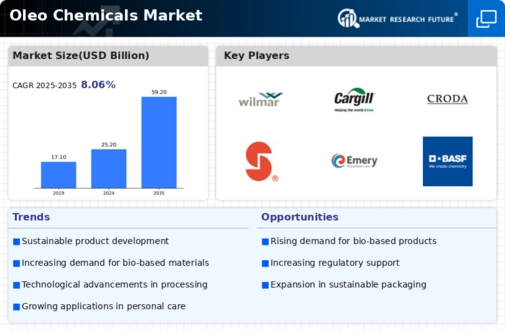Top Industry Leaders in the Oleo Chemicals Market
 Oleo chemicals, derived from plant and animal fats, navigate a dynamic market teeming with competitive players and constant innovation. These versatile, eco-friendly chemicals find their way into everyday products, from soaps and detergents to food additives and plastics. Delving into this multifaceted market requires charting a course through the key players, their strategies, and the currents shaping market share.
Oleo chemicals, derived from plant and animal fats, navigate a dynamic market teeming with competitive players and constant innovation. These versatile, eco-friendly chemicals find their way into everyday products, from soaps and detergents to food additives and plastics. Delving into this multifaceted market requires charting a course through the key players, their strategies, and the currents shaping market share.
Captains of the Oleo Fleet:
-
Wilmar International: This Singaporean giant leads the pack with its extensive global reach and vertically integrated operations, controlling both raw material sources and downstream production. Their focus on cost-effectiveness and diverse product offerings keeps them on top. -
Kao Corporation: This Japanese powerhouse sails with its Kao Chemicals division, specializing in high-purity oleochemicals for personal care and cosmetics. Their emphasis on quality and R&D fuels their market differentiation. -
Evonik Industries: This German titan steers with its TEGO brand, catering to demanding applications like lubricants and coatings. Their commitment to technological advancements and sustainability keeps them afloat in competitive waters. -
Godrej Industries Ltd.: This Indian competitor navigates the market with its Godrej Oleochemicals arm, focusing on industrial applications like rubber and leather processing. Their regional expertise and cost-efficient manufacturing give them a local edge. -
Emery Oleochemicals: This US-based player paddles with its diverse portfolio of specialty oleochemicals for food and pharmaceutical applications. Their commitment to custom formulations and technical support attracts niche customers.
Charting the Oleo Currents: Factors Influencing Market Share:
Beyond brand recognition, several factors steer the winds of market share in the oleo chemicals market:
-
Sustainability Tide: The rising wave of environmental concerns pushes manufacturers towards bio-based and readily biodegradable oleochemicals. Evonik's TEGO* Bio line and Wilmar's collaboration with a renewable energy company for bio-based fatty acids exemplify this trend. -
Regional Growth: Asia Pacific emerges as the rising tide, driven by rapid urbanization and increasing disposable incomes. Wilmar and Godrej Industries are strategically expanding their presence in this region to ride the wave. -
Product Innovation: Developing novel oleochemicals with improved properties like enhanced lubricity, faster curability, or unique functionalities fosters customer loyalty and market penetration. Recent examples include Kao's bio-based emulsifiers for cosmetics and Emery Oleochemicals' low-VOC plasticizers for food packaging. -
Downstream Integration: Integrating forward into downstream applications like soaps and detergents can offer cost advantages and market control. Kao's control over its personal care product lines gives them a significant edge.
Competitive landscape:
- Cargill, Inc.
- SABIC
- Kuala Lumpur Kepong Berhad
- BASF SE
- Oleon N.V.
- IOI Group Berhad
- Wilmar International
Recent Developments:
-
September 2023: Regional expansion continues with Kao's new production facility in China and Emery Oleochemicals' strategic partnership with a distributor in Latin America. -
October 2023: Innovation takes center stage with Kao's development of self-healing oleochemical coatings for automotive applications and Wilmar's launch of a high-lubricity bio-based ester for industrial machinery. -
November 2023: Regulatory concerns emerge with stricter environmental regulations in Europe impacting raw material sourcing for some players. -
December 2023: Industry collaboration flourishes with the formation of a consortium to develop standardized testing methods for oleochemicals.

